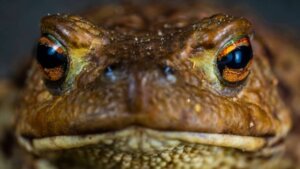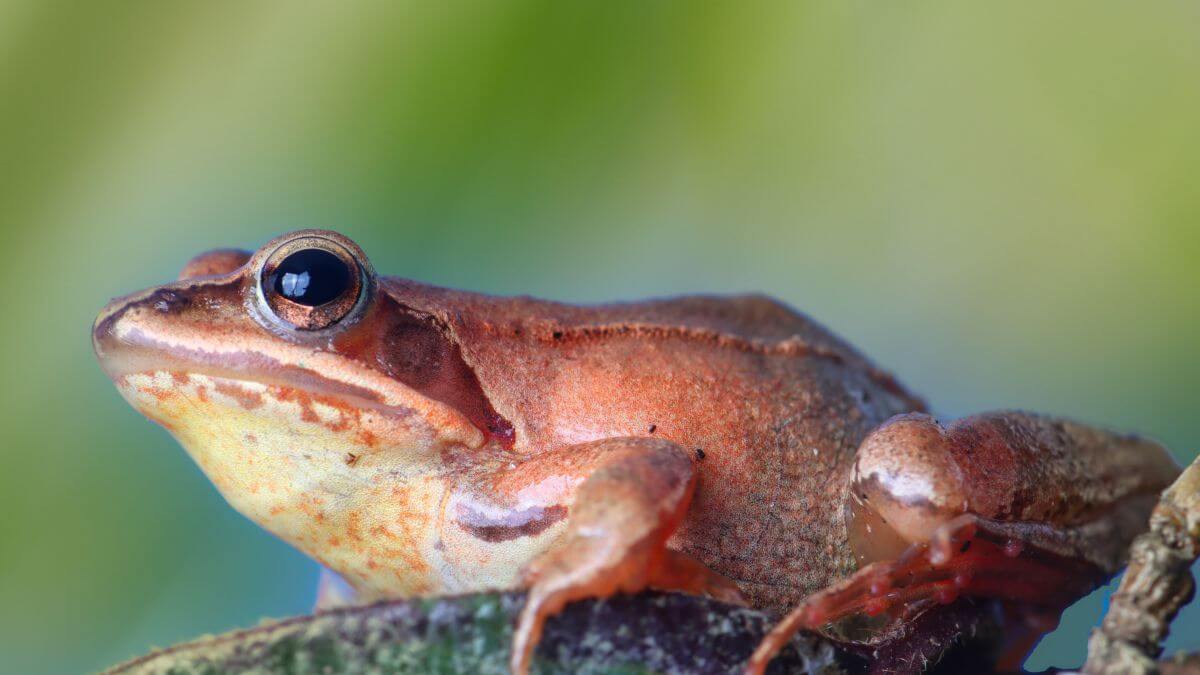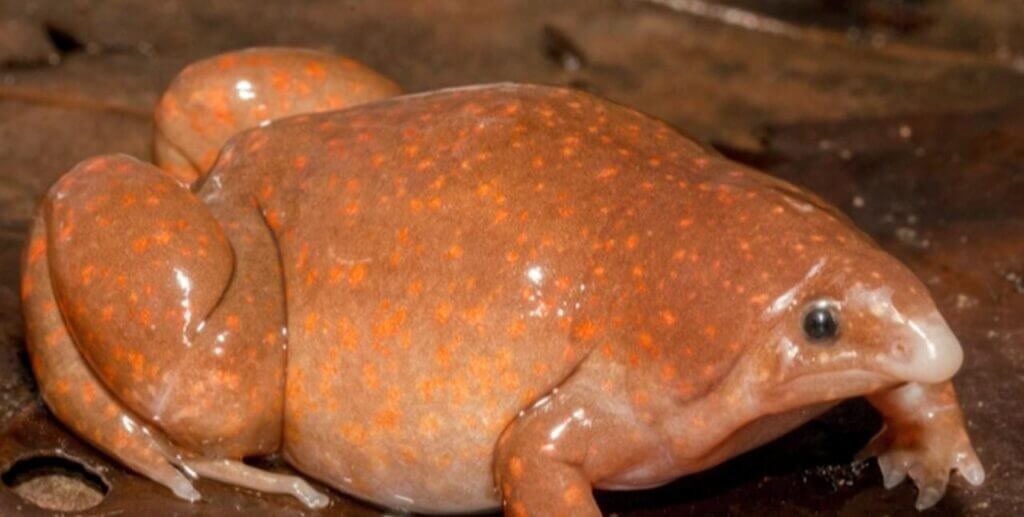Zombie Frog: A New Amazon Species


Written and verified by the biologist Cesar Paul Gonzalez Gonzalez
The zombie frog is an amphibian discovered in the year 2021, about which we know very little. It’s native to one of the areas with the greatest diversity of animals and a paradise for organisms of this type. Due to its uncommon habits, it’s an expert at hiding, which is why we didn’t know anything about it until now!
This frog belongs to the group of synapturids, which are specimens that live in environments with excessive humidity. Specifically, we’re referring to Synapturanus zombie, an incredible amphibian that will surprise you. Read on to learn more about this peculiar animal.
Habitat and distribution of the zombie frog
The entire genus is distributed in the Amazon region, although specifically, the zombie frog is only found in French Guiana and Amapá. Because of this, they maintain a close relationship with the rainforests, as only these provide the necessary humidity for them to survive.
These frogs are usually nocturnal and fossorial, which means they have a great capacity to burrow, preferring subterranean environments. In other words, they spend most of their existence buried, although at certain times if there’s sufficient moisture they’ll come to the surface.

Zombie frog characteristics
This amphibian is very small, barely reaching 40 millimeters (1.7 inches) in length, but boasts a wide, rounded body. In addition, it has protruding eyes, with an elongated nose ending in a snout, which gives it a peculiar-looking face. On the other hand, its limbs don’t have disks on its toes, since, unlike other frogs, its phalanges are a little more elongated.
In addition, the skin of this species appears to be completely smooth and translucent, with brown colors and orange spots on its back. On the other hand, its belly is predominantly white, with shades that reach the tip of its nose.
Although its physical characteristics are shared with the members of its group, its size, coloration and song are some of the particularities of this specimen. In fact, according to an article published in the scientific journal Zoologischer Anzeiger, it’s predicted that there could be several more types of frogs, very similar to this one, but yet to be discovered.
Why does it live in the soil?
These animals have very sensitive skin and, for this reason, they need moisture in the environment to live. Moreover, this explains their fossorial behavior, since moisture is better retained in the mud, while it’s quickly lost at the surface. Therefore, only when there are torrential rains can the frog go outdoors, taking advantage of these times to reproduce.
The zombie frog
The researchers who discovered this species embarked on a mission to find out more about it. In fact, they had to expose themselves to such heavy rains that, on more than one occasion, they ended up totally covered in mud. In fact, the name “zombie frog” doesn’t refer to the frog’s characteristics, but to how they looked after spending hours in the mud.
Reproduction
Like several types of frogs, this amphibian uses its songs to attract females. In fact, the male vocalizes while buried several inches in the mud, leaving all the work to her, who actively searches for him! Playing hard to get!!
Contrary to what you’d expect, these anurans don’t need a body of water to lay their eggs, as their environment is naturally too humid. For this reason, all they do is dig a hole in the mud, where they lay their eggs and fertilize them by means of the amplexus. Moreover, the synapturid group is characterized by very large eggs compared to their size.
Conservation status

Because there’s still a lack of information about zombie frogs, their population status is completely unknown. However, the habitat in which they develop is one of the habitats that has suffered most from deforestation in recent years. In 2020 alone, it is estimated that about 11,000 kilometers (nearly 6900 miles) of trees were destroyed in the Amazon, one of the greatest losses of the decade.
Amphibians are one of the organisms that face the most dangers, due to pollution and the destruction of their home. This is because their skin is extremely sensitive, so any change in humidity or water characteristics can lead to disease. Moreover, minor changes in the composition of the fauna in the ecosystem can also affect their health.
Thanks to the fact that these organisms live in areas where access is difficult, they’re well protected and have been able to survive. However, not everything is good; this same situation makes it impossible to help them in case of an emergency. This ends up being contradictory, as, if we look at it this way, humans can be either their greatest threat or their best way of salvation.
The zombie frog is an amphibian discovered in the year 2021, about which we know very little. It’s native to one of the areas with the greatest diversity of animals and a paradise for organisms of this type. Due to its uncommon habits, it’s an expert at hiding, which is why we didn’t know anything about it until now!
This frog belongs to the group of synapturids, which are specimens that live in environments with excessive humidity. Specifically, we’re referring to Synapturanus zombie, an incredible amphibian that will surprise you. Read on to learn more about this peculiar animal.
Habitat and distribution of the zombie frog
The entire genus is distributed in the Amazon region, although specifically, the zombie frog is only found in French Guiana and Amapá. Because of this, they maintain a close relationship with the rainforests, as only these provide the necessary humidity for them to survive.
These frogs are usually nocturnal and fossorial, which means they have a great capacity to burrow, preferring subterranean environments. In other words, they spend most of their existence buried, although at certain times if there’s sufficient moisture they’ll come to the surface.

Zombie frog characteristics
This amphibian is very small, barely reaching 40 millimeters (1.7 inches) in length, but boasts a wide, rounded body. In addition, it has protruding eyes, with an elongated nose ending in a snout, which gives it a peculiar-looking face. On the other hand, its limbs don’t have disks on its toes, since, unlike other frogs, its phalanges are a little more elongated.
In addition, the skin of this species appears to be completely smooth and translucent, with brown colors and orange spots on its back. On the other hand, its belly is predominantly white, with shades that reach the tip of its nose.
Although its physical characteristics are shared with the members of its group, its size, coloration and song are some of the particularities of this specimen. In fact, according to an article published in the scientific journal Zoologischer Anzeiger, it’s predicted that there could be several more types of frogs, very similar to this one, but yet to be discovered.
Why does it live in the soil?
These animals have very sensitive skin and, for this reason, they need moisture in the environment to live. Moreover, this explains their fossorial behavior, since moisture is better retained in the mud, while it’s quickly lost at the surface. Therefore, only when there are torrential rains can the frog go outdoors, taking advantage of these times to reproduce.
The zombie frog
The researchers who discovered this species embarked on a mission to find out more about it. In fact, they had to expose themselves to such heavy rains that, on more than one occasion, they ended up totally covered in mud. In fact, the name “zombie frog” doesn’t refer to the frog’s characteristics, but to how they looked after spending hours in the mud.
Reproduction
Like several types of frogs, this amphibian uses its songs to attract females. In fact, the male vocalizes while buried several inches in the mud, leaving all the work to her, who actively searches for him! Playing hard to get!!
Contrary to what you’d expect, these anurans don’t need a body of water to lay their eggs, as their environment is naturally too humid. For this reason, all they do is dig a hole in the mud, where they lay their eggs and fertilize them by means of the amplexus. Moreover, the synapturid group is characterized by very large eggs compared to their size.
Conservation status

Because there’s still a lack of information about zombie frogs, their population status is completely unknown. However, the habitat in which they develop is one of the habitats that has suffered most from deforestation in recent years. In 2020 alone, it is estimated that about 11,000 kilometers (nearly 6900 miles) of trees were destroyed in the Amazon, one of the greatest losses of the decade.
Amphibians are one of the organisms that face the most dangers, due to pollution and the destruction of their home. This is because their skin is extremely sensitive, so any change in humidity or water characteristics can lead to disease. Moreover, minor changes in the composition of the fauna in the ecosystem can also affect their health.
Thanks to the fact that these organisms live in areas where access is difficult, they’re well protected and have been able to survive. However, not everything is good; this same situation makes it impossible to help them in case of an emergency. This ends up being contradictory, as, if we look at it this way, humans can be either their greatest threat or their best way of salvation.
All cited sources were thoroughly reviewed by our team to ensure their quality, reliability, currency, and validity. The bibliography of this article was considered reliable and of academic or scientific accuracy.
- Fouquet, A., Leblanc, K., Fabre, A. C., Rodrigues, M. T., Menin, M., Courtois, E. A., … & Kok, P. J. (2021). Comparative osteology of the fossorial frogs of the genus Synapturanus (Anura, Microhylidae) with the description of three new species from the Eastern Guiana Shield. Zoologischer Anzeiger, 293, 46-73.
- López-Rojas, J., & Cisneros-Heredia, D. (2012). Synapturanus rabus Pyburn, 1977 in Peru (Amphibia: Anura: Microhylidae): filling gap. Check List, 8, 274.
- Fouquet, A., Leblanc, K., Framit, M., Réjaud, A., Rodrigues, M. T., Castroviejo-Fisher, S., … & Fabre, A. C. (2021). Species diversity and biogeography of an ancient frog clade from the Guiana Shield (Anura: Microhylidae: Adelastes, Otophryne, Synapturanus) exhibiting spectacular phenotypic diversification. Biological Journal of the Linnean Society, 132(2), 233-256.
- Junior, C. H. S., Pessôa, A. C., Carvalho, N. S., Reis, J. B., Anderson, L. O., & Aragão, L. E. (2021). The Brazilian Amazon deforestation rate in 2020 is the greatest of the decade. Nature Ecology & Evolution, 5(2), 144-145.
- MacCulloch, R. D. (2009). Introduction to the taxonomy of the amphibians of Kaieteur National Park, Guyana. Phyllomedusa: Journal of Herpetology, 8(1), 67-68.
- Nelson, C. E., & Lescure, J. (1975). The taxonomy and distribution of Myersiella and Synapturanus (Anura: Microhylidae). Herpetologica, 389-397.
This text is provided for informational purposes only and does not replace consultation with a professional. If in doubt, consult your specialist.








